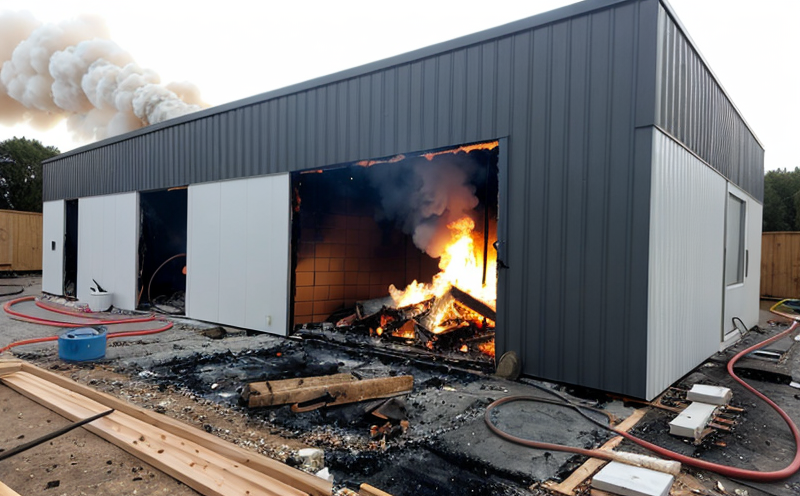Flammability Testing of Wood Fiber Panels
The flammability testing of wood fiber panels is a critical process in ensuring fire safety and compliance with building codes and standards. Wood fiber panels, such as particleboard, medium-density fiberboard (MDF), and hardboard, are widely used in construction due to their versatility and cost-effectiveness. However, their use must be balanced with considerations for fire performance.
The testing process aims to assess the combustibility of these materials under various conditions that simulate real-world scenarios. This involves understanding how the material behaves when exposed to heat or flame, including its rate of ignition, flame spread, and smoke production. The ultimate goal is to provide reliable data that can inform design decisions and ensure compliance with fire safety regulations.
One of the key standards used in flammability testing is ISO 6947, which specifies methods for determining the burning behavior of building materials. This standard provides a framework for conducting tests that are designed to mimic real-world conditions as closely as possible. The test typically involves placing a specimen on a standardized fire source and measuring its response over time.
The testing apparatus used in this process includes a non-return valve, ignition device, and a calorimeter. These tools help to control the environment in which the sample is tested, ensuring that results are consistent and accurate. The specimens are prepared according to specific dimensions outlined by the standard, which ensures uniformity across different samples.
The testing procedure involves igniting the specimen and monitoring its behavior over time. Key parameters measured include the rate of heat release, flame spread index, smoke production, and char depth. These metrics provide valuable insights into the combustibility of the material and help to determine whether it meets specified fire safety criteria.
Understanding these parameters is crucial for quality managers, compliance officers, R&D engineers, and procurement personnel who need to ensure that their products meet strict regulatory requirements. By conducting thorough flammability testing, manufacturers can demonstrate that their wood fiber panels are safe and reliable, which is essential in the construction industry where fire safety is paramount.
Flammability testing plays a pivotal role in ensuring that wood fiber panels contribute positively to fire safety without compromising on performance or aesthetics. This process not only enhances public confidence but also helps to comply with international standards such as ISO 6947 and others specific to the building materials sector.
Eurolab Advantages
EuroLab offers a comprehensive suite of services designed to meet the stringent requirements of fire safety testing for wood fiber panels. Our team of experts is dedicated to providing reliable, accurate, and timely test results that are essential for ensuring compliance with international standards.
- Comprehensive Expertise: With years of experience in fire safety testing, our team has the knowledge and skills necessary to conduct thorough and precise tests.
- State-of-the-Art Facilities: Our facilities are equipped with advanced instrumentation that meets or exceeds international standards. This ensures that we can deliver accurate results consistently.
- Compliance Assurance: We stay up-to-date with the latest regulations and guidelines, ensuring that our testing aligns with current requirements.
- Consultative Approach: Our team works closely with clients to understand their specific needs and provide tailored solutions. This includes offering recommendations for improving fire safety performance based on test results.
- Prompt Reporting: Results are delivered quickly, allowing clients to make informed decisions promptly.
- Confidentiality: We respect the confidentiality of our clients' information and ensure that all data is handled securely.
EuroLab's commitment to excellence has earned us a reputation for delivering high-quality services. Our approach not only ensures compliance with regulations but also enhances product performance, contributing to safer buildings and structures.
Quality and Reliability Assurance
- Controlled Environment Testing: All tests are conducted in a controlled environment that closely simulates real-world conditions. This ensures that the results are relevant and applicable to actual use cases.
- Standardized Procedures: We adhere strictly to internationally recognized standards such as ISO 6947, ASTM E84, and EN 13501-1, which provide clear guidelines for testing procedures. This standardization ensures consistency in results across different tests and laboratories.
- Regular Calibration: Our instrumentation is regularly calibrated to ensure that all measurements are accurate and reliable. This reduces the risk of errors or inconsistencies in test results.
- Digital Reporting: Results are provided in a digital format, which makes it easier for clients to review and share with stakeholders. This also ensures that data can be easily integrated into other processes.
- Quality Control: We maintain strict quality control measures throughout the testing process to ensure high standards of accuracy and reliability.
The combination of these factors guarantees that the results obtained from our tests are trustworthy and reliable, providing clients with confidence in their product's fire safety performance.
International Acceptance and Recognition
- ISO 6947 Compliance: Our testing methods fully comply with ISO 6947, which is widely accepted internationally as a standard for determining the burning behavior of building materials.
- ASTM E84 Approval: ASTM E84 provides another recognized framework for assessing flame spread and smoke development in building materials. We ensure that our tests are conducted according to this standard.
- EN 13501-1 Acknowledgment: The European standard EN 13501-1 is used extensively across Europe for fire safety testing of construction products. Our facilities and procedures meet the requirements specified in this standard.
- IEC Standards: We also adhere to IEC standards, which are relevant for electrical and electronic equipment that may be used in conjunction with building materials.
The acceptance of these international standards ensures that our testing results are recognized worldwide. This broad recognition enhances the credibility of our services and supports global trade by ensuring consistent quality across different regions.





